Light therapy involves exposure to an artificial light source that mimics the sun. Exposure to natural sunlight helps promote the production of melatonin and serotonin, which play a role in mood-regulated sleep energy and mental health. A decrease in sun exposure may lead to reduced production of these critical hormones. Light therapy replaces sun exposure.
An artificial light source with a specific brightness intensity can produce the same results as exposure to natural sunlight. It helps promote the production of serotonin and melatonin, which can help treat various conditions that can occur when these hormones are deficient.
This meta-analysis of 19 randomized clinical studies involving light therapy as a treatment for seasonal affective disorder found it was an effective treatment over the placebo in decreasing symptoms.
Light therapy may also help in treating sleep disorders. Exposure to a sun lamp may shift the circadian phase and suppress melatonin production as a response to light exposure.
While studies have shown bright light as an effective treatment for several conditions, it is important to follow best practices. Following best practices may help improve your chances of receiving effective treatment.
The guide below provides information on how to use bright light therapy most effectively so that you can get the most out of it.
Timing
Following sun lamp instructions also includes the correct timing. Timing bright light therapy at a specific time of the day is vital to make the most of the treatment.
Research indicates that using bright light in the morning, ideally before 8:00, is most effective when treating seasonal affective disorder. Morning light appears to be more effective than midday or evening light in treating various conditions. It is even better to use your therapy light lamp when the sun is rising during the summer months.
Using bright light therapy within an hour of waking up for 20 to 30 minutes has shown to be the most effective. This helps your body produce serotonin, which combats depression and enhances mood.
Using your lamp early in the morning when the sun is rising mimics natural exposure to sunlight. This sends a signal to your brain to wake up and may increase your energy level.
For individuals treating seasonal affective disorder, it is best to start daily exposure in the fall, when the days become shorter and cloudier.
The timing of light exposure is also vital to achieving the most beneficial effects for treating sleep disorders. For instance, the effects of light therapy on the phase of the circadian clock depend on the timing of the light exposure. Research indicates that morning light exposure advances an individual's circadian clock, while evening exposure to light therapy delays it.
While experts recommend using bright light therapy within an hour of waking up, there are exceptions to this rule. For instance, if you're a night shift worker, you may be on a different schedule of bright light therapy.
Incorrect timing of bright light may have an adverse effect. For instance, exposure to bright light too late in the day may hinder melatonin production and negatively affect sleep.
One of the most critical aspects of using bright light therapy is consistency. In most instances, daily exposure to light therapy is recommended.
Can You Use a SAD Light Too Much?
It is common to wonder if you can use a SAD light too much. The answer is, possibly. Too much exposure to light therapy can cause your circadian rhythms to become unbalanced.
How long to use a light therapy lamp may be one of the first questions you have. However, using light therapy may take a little trial and error.
Similar to most types of treatment and medication, light therapy may need a little adjustment. At first, limit your light therapy sessions to 20 to 30 minutes. Gauge your response to therapy and adjust as needed. However, exceeding 40 minutes of light therapy has been found to have no additional benefits.
Positioning: Where to Place Your Lamp
Positioning your lamp optimally helps provide the best treatment. For instance, indirect light may take longer than the 20-to 30-minute treatment time to produce benefits, or it may not produce the benefits you're looking for.
Ideally, the light should shine directly into your eyes. This doesn't mean you have to stare into the light during treatment. Instead, your eyes should be centered with the lamp tilted at 15° if it is shining downwards. Keep in mind that your exact sitting distance will vary depending on the model.
Best practices for using light therapy include sitting roughly 16 to 24 inches from the light if your light produces 10,000 LUX. If sitting this close causes any adverse effects, you can sit a little further away and have a longer session.
Correct and Incorrect Position
A few reminders for correct positioning versus incorrect includes the following:
Correct
- Sitting 16 to 24 inches in front of the screen with it shining directly into your eyes
Incorrect
- Sitting further than 24 inches without extending your treatment time
- Sitting too close may be harmful to your eyes
- Sitting with your head down, not getting direct sunlight
Keep Track of Your Treatments
How to use a sun lamp also includes tracking your treatments. Adverse side effects of light therapy are generally mild. However, it is important to keep track of any negative side affects you experience.
According to the Yale School of Medicine, possible side effects of light therapy include headache or eye strain. Some individuals may also find they become overstimulated, irritable, or agitated with light therapy. Nausea may also be a possible side effect.
These side effects are generally mild. However, if they become bothersome, you may need to adjust your treatment time.
Add Other Holistic Practices
Light therapy alone may not be enough to improve sleep, mental well-being, and energy. It's often helpful to implement a combination of holistic practices. Light therapy tends to be a supplementary treatment, which means it usually requires the addition of other best practices.
The practices below are often helpful to improve energy, mood, and mental well-being and do not have any adverse side effects.
Yoga: Yoga combines breathing exercises, physical postures, and meditation. Yoga may help improve mood and energy. This study involved 246 participants and compared yoga practice to Pilates exercise in treating mental health disorders.
The study divided the participants into two groups. One group practiced yoga, and the other group practiced Pilates exercise. Although exercise, in general, helps treat mood disorders, the study found yoga was superior to Pilates when treating mental health disorders.
Exercise: Regular physical exercise improves hypothalamus pituitary-adrenal-axis function, which may affect the production of certain neurotransmitters that promote calmness and a sense of well-being.
A review published in the Journal Cureus found that anxiety and depression appear to be improved by physical exercise. Try to engage in some type of physical exercise such as brisk walking, biking, or swimming on most days of the week for about 30 minutes.
Eat a well-balanced diet: Certain nutritional deficiencies can decrease energy and maybe even affect emotional well-being. Eating a well-balanced diet, including plenty of fruits, vegetables, lean protein, and healthy fats, promotes overall good health and emotional well-being.
Spend time outdoors: Spending time outdoors may also help improve energy and mood. According to UC Davis Health, it may also reduce anxiety and anger.
This study included over 900,000 children and found that children who spent more time outdoors had a lower risk of mental health disorders. The study found that children who grew up with the lowest level of green space had up to 55% higher risk of developing a psychiatric disorder independent from other known risk factors.
Follow best sleep practices: Poor sleep quality or sleep deprivation can significantly affect energy level, mood, and overall quality of life. This 2019 study involved 208 adults who reported their mood and sleep patterns daily using mobile phones for 6 weeks. Researchers found that daily sleep quality and mood were related. Sleep quality had a significant effect on mood. To a lesser extent, a person's mood also affects their sleep quality. Sleep practices that promote quality sleep include:
- Aiming for 7 to 8 hours of sleep each night
- Going to bed and waking up at about the same time each day
- Limiting caffeine several hours before bed
- Sleeping in a cool, quiet environment
Consider supplements and vitamins: Vitamins and supplements are meant to complement a healthy diet. Certain vitamins may play a role and decrease energy. If you are deficient in certain vitamins, supplements may be helpful. For example, magnesium might help you relax and feel calm, which may promote sleep. However, before taking any type of supplement, it's best to discuss it with your doctor to make sure it is the right supplement for you.
Developing a Morning Routine with Light Therapy
Developing a morning routine is important to maintain consistency. Although studies on the benefits of morning routines are scant, it makes sense that a morning routine can positively kick-start your day. According to the National Alliance on Mental Illness, developing a morning routine can increase your productivity, energy, and positivity.
Making light therapy a part of your morning routine can help empower you to start the day with a positive mindset. Knowing you're doing something for your health can also motivate you to make additional healthy choices.
When using light therapy, you can simply sit quietly with your thoughts. However, you may want to combine light therapy with additional activities you do in the morning. Some ideas for activities to do while using light therapy include the following:
- Use in the bathroom while getting ready in the morning
- While completing your morning stretches
- Eating a well-balanced breakfast
- Planning your day
- Writing in your journal
- Catching up on the news or emails
- At your desk as you start your workday
Common Mistakes to Avoid
When doing light therapy, it's important to avoid common mistakes such as the following:
- Sitting an incorrect distance from your light therapy lamp may not provide the dose of light needed.
- Sitting at the wrong angle. The light needs to hit your eyes like the sun to produce the same effects. Indirect light isn't nearly as effective and may not produce any benefits.
- Having light exposure at the wrong time of the day may interfere with proper sleep.
- Using a light that does not provide adequate brightness will not provide the therapeutic affects you need.
- Being inconsistent with light therapy will not provide optimal benefits.
- Only using light therapy and not utilizing other treatments may not be an effective strategy to treat the condition you are targeting.








Leave a comment
All comments are moderated before being published.
This site is protected by hCaptcha and the hCaptcha Privacy Policy and Terms of Service apply.